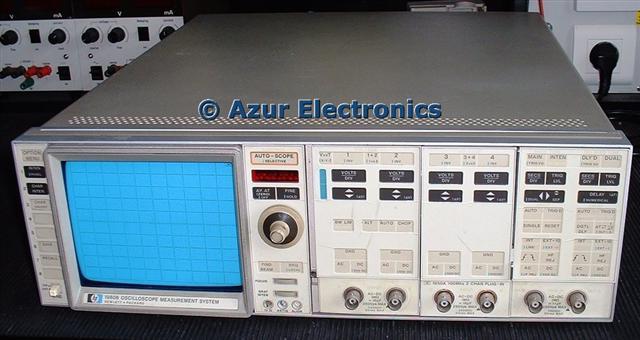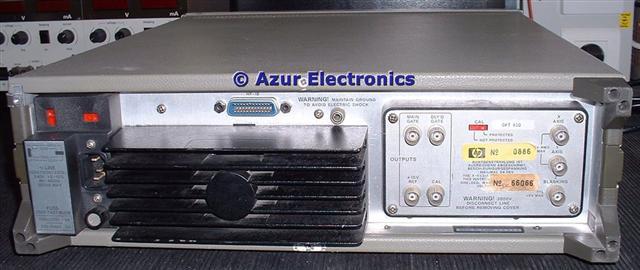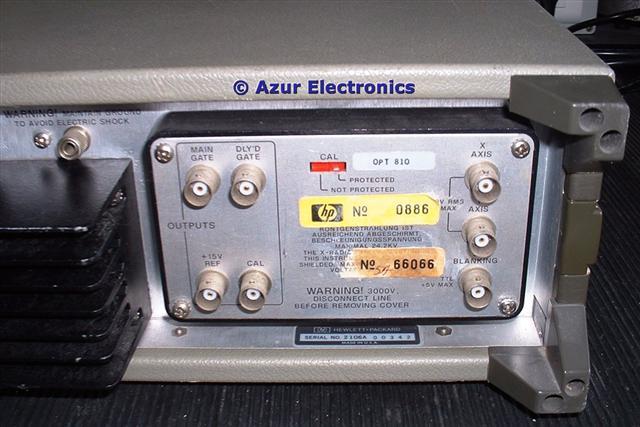
Welcome to
Azur Electronics
Azur Electronics
HP 1980B OSCILLOSCOPE
Home
Projects
Test Equipment
- Accessories
- Adaptors
- Amplifiers
- Attenuators
- Cables
- Frequency Counters
- Logic Analysers
- Multi-Meters
- Network Analysers
- Oscilloscopes
- Power Meters
- Power Supplies
- Prototyping Equipment
- Signal Generators
- Spectrum Analysers
- Tools
Operating Information
- Operating HP 141T
- Operating HP 1630D
- Operating HP 8175A
- Operating HP 8407A
- Operating HP 8410C
- Operating HP 8552B IF Section
- Operating HP 8553B RF Section
- Operating HP 8554B RF Section
- Operating HP 8555A RF Section
- Operating HP 8556A LF Section
- Operating HP 8594E Spectrum Analyser
- Operating HP 8901B
- Operating LeCroy 9310
Technical
- Allen Key Sizes
- High Voltage Measurement
- HP Cases
- HP Information
- HP-IB Interface Bus
- Measurement Units
- Motorola ECL
- RF Connectors
- RF Power - Voltage Conversion
For Sale
Wanted
Links
About Me
Contact Me
Site Map
To give this its full title of "Oscilloscope Measuring System" sounds much grander and reflects its HP-IB programming and measurement reporting. This was the first analogue oscilloscope with digital control by microprocessor. Available in a conventional 'A' version (but quickly dropped from production) or 'B' rack mounting version, the 1980B is a complicated Oscilloscope. As well as being a heavy item of test equipment at 18.2kg, the Operating, Programming & Service Manuals weigh almost as much.
Introduced in 1980, in 1982 the 1980B cost $9,000, the 1950A $2,100, the 1965A was not listed in the catalogue until 1985 and in 1986 cost $2,550. Other items were the 19810A Sequence ROM for $400 (which is fitted - Option 810), the 19811A Plot/Sequence ROM for $500 (not fitted) and the 19860A Digital Waveform Storage for $2,750 (which is also fitted). A very expensive beast as well, this all totalled $19,450 in 1986.
Introduced in 1980, in 1982 the 1980B cost $9,000, the 1950A $2,100, the 1965A was not listed in the catalogue until 1985 and in 1986 cost $2,550. Other items were the 19810A Sequence ROM for $400 (which is fitted - Option 810), the 19811A Plot/Sequence ROM for $500 (not fitted) and the 19860A Digital Waveform Storage for $2,750 (which is also fitted). A very expensive beast as well, this all totalled $19,450 in 1986.

Front view showing plug-in modules in the centre
This is a very complex Oscilloscope with Expansion Modules, Key Sequence ROM Option, HP-IB Programming, Autoscope function, Save/Recall for 8 setups, and Calibration System.
It comes with 2 optional plug-in modules: the HP 1950A 100MHz 2 Channel Plug-In; and the HP 1965A Gated Universal Counter complete with their Manuals.
It comes with 2 optional plug-in modules: the HP 1950A 100MHz 2 Channel Plug-In; and the HP 1965A Gated Universal Counter complete with their Manuals.

Rear view
As well as the HP-IB programming connector, Rear Panel connections are: Main Gate; Delayed Gate; +15V Reference; Cal Output; X Axis; Y Axis; and Z Blanking. There is also a switch to protect or not protect the calibration of the Oscilloscope.

Rear view showing connectors
Additional information on the HP 1980A/B is available in the September 1982 edition of the HP Journal.
January 2007
The Operator's Checks showed that the Oscilloscope had some significant faults, so repair work is therefore required. For details see Repair HP 1980B Oscilloscope.
May 2010
Now that this Oscilloscope is back in service, it is a real pleasure to use. It is very useful to be able to 'dial-up' various vertical and horizontal deflections instead of being restricted to the usual 1,2,5 sequence of conventional oscilloscopes. There is also the sense of making use of a product with historical significance. I wonder how many modern oscilloscopes will last as long as the 1980B.
February 2011
Now Sold (thanks Marc).
January 2007
The Operator's Checks showed that the Oscilloscope had some significant faults, so repair work is therefore required. For details see Repair HP 1980B Oscilloscope.
May 2010
Now that this Oscilloscope is back in service, it is a real pleasure to use. It is very useful to be able to 'dial-up' various vertical and horizontal deflections instead of being restricted to the usual 1,2,5 sequence of conventional oscilloscopes. There is also the sense of making use of a product with historical significance. I wonder how many modern oscilloscopes will last as long as the 1980B.
February 2011
Now Sold (thanks Marc).